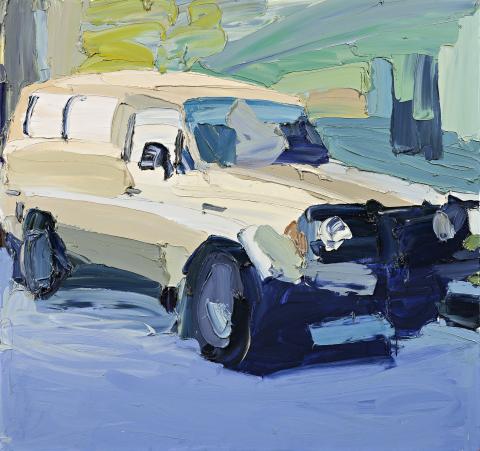ONE BIG ONE, 2005
BEN QUILTY
oil on linen
160.5 x 170.0 cm
signed, dated and inscribed verso: Australian Landscape / [...] / Ben Quilty 2005
GRANTPIRRIE, Sydney
Private collection, New South Wales
Ben Quilty: Ache, GRANTPIRRIE, Sydney, 7 March – 1 April 2006 (stamped verso)
Friends and Neighbours, Hawkesbury Regional Gallery, New South Wales, 14 September – 30 October 2005 (invitation attached verso)
Slade, L., BEN QUILTY LIVE!, exhibition catalogue, University of Queensland Art Museum, Brisbane, 2009, pp. 50 – 51 (illus.)
At a time in their lives when many young, straight, white males are staggering their way through perceived rites of passage, artist Ben Quilty turned a mirror on himself and his friends. In doing so he geared his paintings towards images which explored the young men’s search for masculine identity. Quilty honed in on images of motor vehicles which came to reflect the identities of their owner/drivers. Along with fast food, alcohol and drug references; these Kombis, Valiant Chargers and LandCruisers became enduring motifs which he used to convey his ideas.
The nuggetty Holden Torana, with its V8 engine crammed under the hood became a Quilty favourite. The Torana entered Australian folk lore in 1972, when Peter Brock drove it to victory against the dominant Ford Falcons at Bathurst’s annual orgy of booze and petrol on Mount Panorama. In the decades that followed the popular Torana (an Aboriginal word meaning ‘to fly’) became the choice of young men when buying their first second hand car. By the time Ben Quilty got his ‘P’s, the choice was easy. With Brocky’s place in the male psyche secure and John Meillon’s Victoria Bitter jingle as the sound track, Quilty and his mates took to the road in their adolescent quest for meaning and direction, all the while dangerously testing the boundaries of common sense.
Quilty’s depiction of a Toyota LandCruiser in One Big One, 2006 represents a desire to identify with the tough talking, hard working Australian male of the outback. It says, ‘I belong to the no-bullshit, can-do men of the real Australia’. Amidst the yarns and myths that ferment in pubs across the outback, the Toyota LandCrusier, parked out the front pulsates with masculine credibility.
One Big One, 2006, was first exhibited in his 2006 exhibition titled Ache, the first of his four solo exhibitions at Sydney’s GRANTPIRRE Gallery. Within the exhibition/installation One Big One, was the third of four canvases, which, when hung together formed one work. The entire work was titled Nelson Street Serpent, and stretched to eight metres. Each canvas depicted a motor vehicle, and doubled in size from left to right. The overall image appears to be a row of parked cars, but as the viewer’s eye follows the work left to right it grows and evolves into one of Quilty’s fanged, skull like white vans. Describing the work in the exhibition catalogue, Clare Lewis wrote...
‘Collectively spanning the length of the gallery wall, this street scene is a bold still-life which treats vehicles like life-models, each commanding an imposing, individual personality and perspective. Far from vessels which transport passengers from A to B, Quilty sees every vehicle as a telling extension of its owner, prosthesis of each character type perhaps. They can also be viewed as a symbol of the initiation process of almost every young Australian into the mobile market economy, a sexual rite of passage or a first taste of freedom for every new owner’.1
Ben Quilty’s paintings ooze both paint and metaphor. His technique of applying paint in broad, thick swathes using cake decorator’s tools creates a fleshy sculpted surface, which in itself parallels the youthful bravado his paintings aim to depict. Quilty’s use of paint involves bulking it up with white, this results in a soft harmonising effect that belies the artwork’s chaotic and ominous undertow and, as is his intent, takes the viewer along for the ride.
1. Lewis, C., Ache, catalogue essay, GRANTPIRRE, Sydney, 2006
HENRY MULHOLLAND
